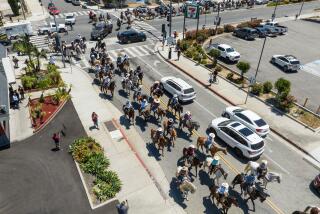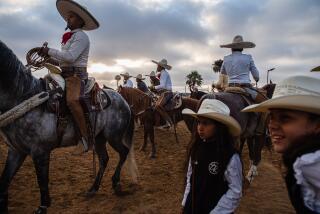Peru’s Paso Horses Step Out of Isolation
- Share via
LIMA, Peru — In white poncho and scarf, broad-brimmed hat and silver spurs atop his horse Caramelo, Olaf Hein is the vision of a rider from Peru’s colonial past.
A tall, white-haired child of German immigrants, Hein has fought off leftist guerrillas who came to kill him, refusing to leave his ranch on the northeastern outskirts of Lima where he breeds Peruvian paso horses.
Although Hein seems a holdover from a different age, it is his horses that are direct descendants of the war steeds brought to Peru nearly 500 years ago by Spanish conquistadors.
Paso horses are known for a high-stepping gait that allows them to trot with virtually no movement of their backs, making their ride smooth and easy.
As Peru sank into guerrilla warfare and economic chaos in the 1980s, Hein and other breeders stubbornly protected the horse’s ancient bloodline and cultivated its gait.
“We stuck it out through the dark times and resisted the new trends in breeding because we felt we had the best horses in the world, and now some people are seeing it our way,” Hein said.
The Peruvian Congress passed a law last year declaring the paso horse “a breed native to Peru,” giving it special protection as an important part of Peru’s cultural heritage.
What makes paso horses unique is their gait. They move their front and back legs on the same side in step, giving them a fluid movement.
The standard trotting horse moves the front leg on one side in step with the back leg of the other side, giving it a bouncing motion that is hard on the rider. Paso horse breeders call them “bone-shakers.”
The paso horse is born with its smooth gait, and breeders train them to add a high step called a termino. The termino is a graceful movement in which the forelegs roll outward as the horse strides forward, like the arm motion of a swimmer.
“This horse will make you look like an accomplished rider the first day you are on it,” said Ken Agid, a paso horse breeder from Newport Beach, Calif., who was in Peru for a competition.
Jerry Hillard of Dillon, Colo., another paso horse breeder, said: “The benefit of the horse is that it’s the smoothest-riding horse in the world. It has a natural gait that assures you don’t bounce.”
At paso horse competitions in the United States, riders carry glasses of champagne and try not to spill any.
In Peruvian competitions, poncho-clad riders known as chalanes guide paso horses through figure eights and even a dance native to northern Peru known as the “marinera.” The horse, with the chalan atop, dances with a woman in an elegant floor-length skirt.
Peruvians closely managed the breeding of paso horses for centuries under the shadow of the Andes, and would not sell top horses abroad until about 35 years ago, Agid said.
A top breeding stallion can sell for up to $100,000, Hein said. The average price for a paso horse runs between $10,000 and $15,000, he added.
Historians say the paso horse, glorified in Peruvian poetry and song, was brought to Peru by Spanish conqueror Francisco Pizarro.
The paso horse’s gait was the standard for horses before the 17th century, Hein said.
Then a revolution in breeding took place as the use of carriages grew and armies sought quick, mobile horses for new modes of warfare. Trotting horses were better suited for those needs, and by the end of the 17th century non-trotting horses were rare, Hein said.
Hein estimates there are about 25,000 paso horses in the world, with 7,000 to 8,000 in Peru, 7,000 in the United States and Canada, 5,000 in Argentina, 3,500 in Central America and 1,500 in Ecuador.
The tradition of paso horses almost came to an end in the last decade because Peru’s bloody guerrilla war caused many breeders to flee the country. Most breeders were wealthy and lived in areas of high rebel activity.
Hein was ambushed and his truck riddled with bullets by Shining Path guerrillas in 1991 near his horse farm. He survived the attack and stayed in Peru, but he sent his family to live abroad.
With the war winding down in recent years and President Alberto Fujimori making free-market economic reforms, breeders returned and the number of paso horses has been rising.
“They are an elegant horse that is a joy to ride. It’s a tradition that should not end,” Hein said.
More to Read
Sign up for Essential California
The most important California stories and recommendations in your inbox every morning.
You may occasionally receive promotional content from the Los Angeles Times.













